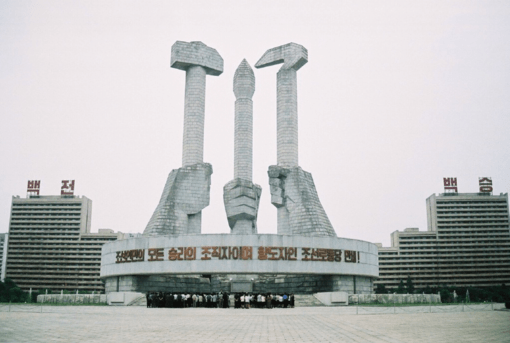
Photo by Kamil Antosiewicz Monika Powalisz | CC BY 2.0
1) The North Korean (DPRK) leadership considers the development of nuclear weapons as vital to national security.
Why? There are 70,000 U.S. troops in Japan and South Korea, and Pyongyang is in Washington’s nuclear cross hairs. B-52s over South Korea provide a “nuclear umbrella” (as the Pentagon puts it). The U.S.-led war of 1950-1953 (to prevent the reunification of the country under Pyongyang’s leadership) resulted in the death of around three million civilians.
Washington’s hostility has been unremitting. After signing the “Agreed Framework” with Pyongyang in Geneva, in August 1994—which called for North Korea to freeze and eventually eliminate its nuclear facilities, in exchange for two light water reactors financed through the Korean Peninsula Energy Development Organization (KEDO), a multinational consortium—Washington could have halted the program. But the Bush/Cheney administration, to the horror of South Korean President Kim Dae-jung, opposed his “Sunshine Policy” of rapprochement with North Korea and helped sabotage the agreement.
2) An ICBM that can strike the Aleutians can strike Vladivostok or Beijing. Look at a map. The Russians and Chinese are as concerned about the North Korean program as much as the Americans. Moscow and Beijing have proposed that the crisis be settled by an agreement by the U.S. and South Korea to suspend annual joint military exercises and the deployment of the THAAD anti-ballistic missile system (unpopular in South Korea itself), in return for a freeze of the DPRK nuclear program.
This is a reasonable proposal, made by Chinese President Xi Jinping and Russian President Vladimir Putin, whom we might call (in relation to Donald Trump) “respected world leaders.”
3) The U.S. has rejected this proposal out of hand. It values the “Foal Eagle” joint military exercises in South Korea every year, some of the largest field exercises in the world, sometimes involving over 200,000 troops. (This rejection might not enhance global perceptions of the U.S. A recent PEW poll shows that only 49% of people around the world now see the U.S. favorably, down from 64% a few years ago.)
4) The U.S. is led by an unstable, impulsive president who said in January: “North Korea just stated that it is in the final stages of developing a nuclear weapon capable of reaching parts of the US. It won’t happen!”
Pyongyang is now provoking him with this message: “Trump blustered early this year that the DPRK’s final access to a nuclear weapon that can reach the US mainland will never happen. But the strategic weapons tests conducted by the DPRK clearly proved that the time of its ICBM test is not a long way off at all.”
5) Trump has become a figure of ridicule on cable TV, is vastly unpopular, is weak politically, under pressure to display his manhood. He recalls how wildly popular his strikes on Syria and the dropping of that mega-bomb on Afghanistan were.
(Recall how Brian Williams was so moved he quoted a Leonard Cohen song about “the beauty of our weapons”). Liberal anchors declared that Trump “became president” in such moments. All that must have been gratifying to a man so insecure he used to pose as his own publicist (as “Marc Fisher”) to boast about his sexual conquests to the tabloids.
6) Talking heads call for “more sanctions,” which at this point means sanctioning Chinese banks that finance trade with North Korea and their associates, and pressuring China to stop buying DPRK coal. But sanctions famously do not work. The North Korean economy has apparently improved in recent years, despite them, and tourists in the country report lots of foreign consumer goods imported through China or perhaps a few other friendly countries (such as Malaysia or Cambodia). It might be politically necessary to announce a new “round” of sanctions to assure the U.S. public that something, anyway, is being done. And leave it at that.
7) But massive military preparations are being made for an attack on North Korea as we speak. George Friedman notes that on May 20, the USS Carl Vinson supercarrier and USS Ronald Reagan were both within striking distance of North Korea. “More than 100 F-16 aircraft are conducting daily exercises in the area, a tactic that foreshadowed the beginning of Desert Storm in 1991. F-35 aircraft have also been deployed to the area, and US government representatives are expected to brief Guam on civil defense, terrorism, and Korea on May 31”.
Meanwhile U.S. Ambassador to the United Nations Nikki Haley tells the U.N. Security Council that North Korea’s actions were “quickly closing off the possibility of a diplomatic solution” and that, “One of our capabilities lies with our considerable military forces. We will use them if we must, but we prefer not to have to go in that direction.”
8) Trump is surrounded by military leaders who presumably want to avoid World War III. He has a good relationship with President Xi, and respects Vladimir Putin. Both of them will urge restraint, for obvious reasons.
9) But Trump will likely insist on the need to do something, and ask his generals for a list of options—from apocalyptic to merely symbolic—to vent his wrath and boost his ratings. This happened before the April 7 missile strike on the Syrian air base.
10) For insight into Trump’s thinking, let us keep watching his 4:00 a.m. tweets.